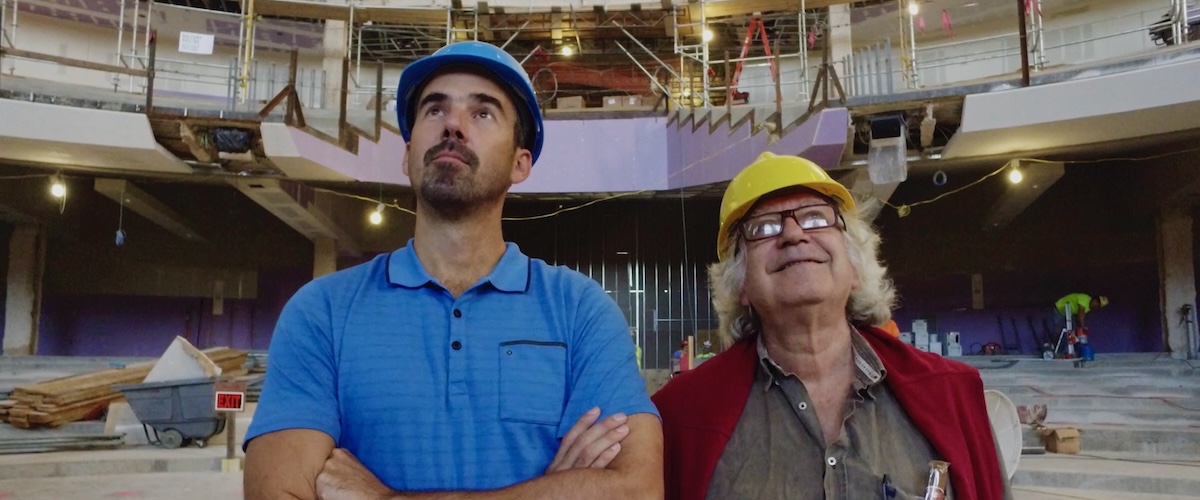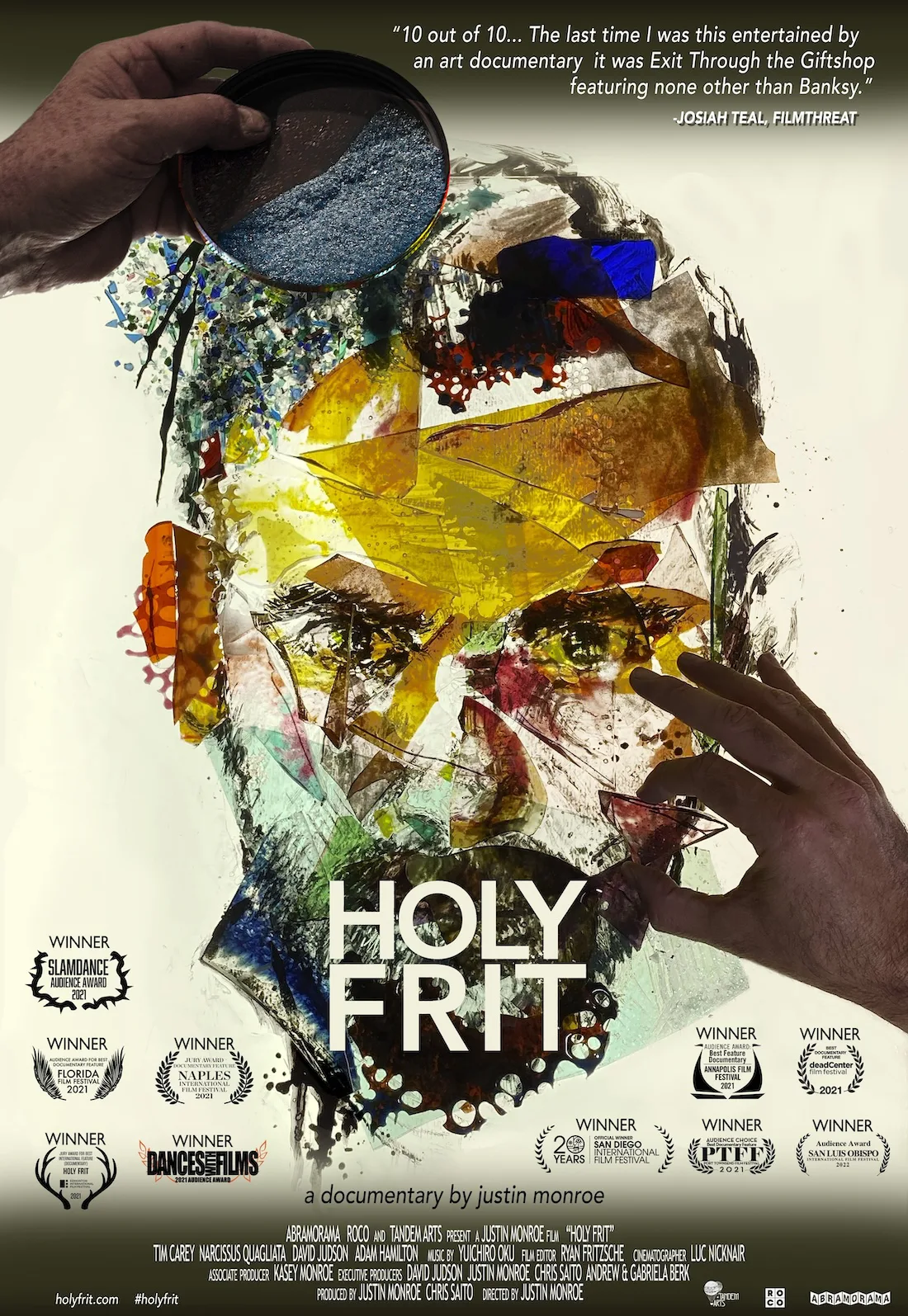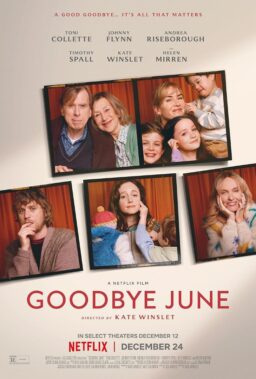On December 22, 2014, an article appeared in the Wall Street Journal titled Window Pains: Stained Glass Faces Dark Days. It profiled Judson Studios, located in Los Angeles, a stained glass studio since 1897 (still run by the Judson family, making it five generations and counting). The article detailed how the demand for stained glass isn’t what it was in the Middle Ages. Stained glass is associated with churches, and the 20th century has seen a steep drop in church attendance. Another factor is the change in church architecture trends over the last half a century. Modern churches look like conference halls. Megachurches look like stadiums. There isn’t demand for colored panels shining through a dark interior. Is stained glass—a craft now a thousand years old—destined to be like illuminated manuscripts, an obsolete relic of the medieval period, albeit beautiful and astonishing?
The documentary “Holy Frit,” directed by Justin S. Monroe, is not a formal history of stained glass, featuring scholars walking us through the timeline. The documentary takes place in the thick of activity at Judson Studios, among the artisans devoting their lives to stained glass. This includes Tim Carey, the central character, who began as an oil painter before ending up at Judson. In 2014, Judson got a commission to build a stained glass window for the Church of the Resurrection in Kansas City. Pastor Adam Hamilton envisions something awe-inspiring for the new sanctuary under construction: he wants a window to fill an entire wall. This window will be 4,000 square feet, which—for perspective—would make it one of the largest stained glass windows in history. (Diagrams are presented for comparison: Chartres Cathedral’s famous window is 1,224 square feet, and the window at Notre Dame is 1,406 square feet). The window will be almost as large as a basketball court. Tim is in charge of coming up with a design.
“Holy Frit” is the documentation of the process, start to finish, from design to unveiling. It takes almost two years of constant work, facing accumulating problems, backs-and-forth with the church over the design, and a very stressful hard deadline. “What keeps me up at night is we don’t know how we’re gonna do this,” says executive director David Judson. The window will be 161 panels. Each panel is a massive 4′ x 5′. Tim’s design is almost psychedelic, proliferating with figures, details, starry night skies, exploding green trees, and swirls of color. The standard stained glass process—with single colors for each panel—won’t suffice. Enter Narcissus Quagliata, a maestro of stained glass with a storied reputation. His designs are bold and radical, opening up modern paths for stained glass. Judson Studios invites Narcissus to the studio for two weeks, hoping he can set them on the right path with his new techniques.
One of the techniques is sprinkling what they call “frit” (finely ground colored glass) across the completed panels, like shaking sugar on top of cookies before putting them into the oven. The “frit” fuses with the existing panels, creating these painterly impressionistic effects, with colors bleeding into other colors. Quagliata gives the studio a crash course in “frit.” Everyone is outside their comfort zone. (The explanations about how different colors must be treated, and how challenging it is to create something that will survive the cooling process, are excellent and informative).
Monroe does an incredible job bringing us through each stage of construction while allowing space for other bigger themes, like art, faith, commerce, and the personal stories of everyone involved. Tim is the center, and he is stressed-out, sarcastic, put-upon, in over his head. There’s the one glass cutter who keeps saying calmly they won’t finish in time. Even the guy who drives the semi-truck carrying the huge panels from California to Kansas City is interviewed about what entails the loading process of such fragile cargo. Narcissus, smoking cigars on his short breaks, is a major figure who ends up being Tim’s mentor, helping him gain confidence while also scolding him out of his fatalistic, pessimistic attitude. Narcissus’ belief in Tim helps Tim step up. It was great to meet Quentin, a 19-year-old former drug addict who got a job at Judson Studios sweeping floors and, by the end of the documentary, is practically running the studio, even sprinkling frit across the huge panels.
Something about Monroe’s approach is so intimate. “Holy Frit” covers so much ground, yet it is amazingly full of feeling. I was almost surprised when I found myself in tears at the unveiling of the window (you can see the completed window here), and how moved I was by Quentin’s pride at how far he has come in life, how wonderful it is to have people believe in you and give you a chance. One of the gifts of well-done documentaries is their immersion into subcultures invisible to those on the outside. “Holy Frit” makes it visible, like sun shining through colored glass.
Now playing in select theaters.




















